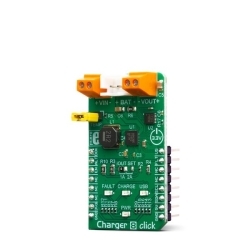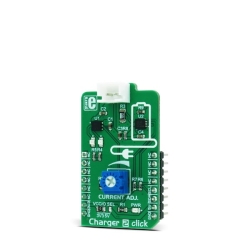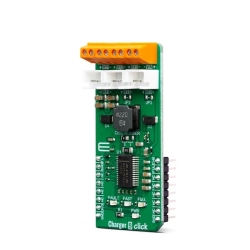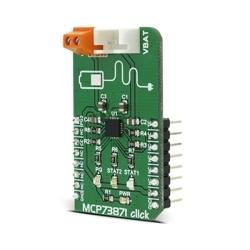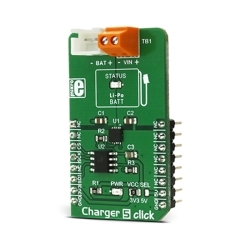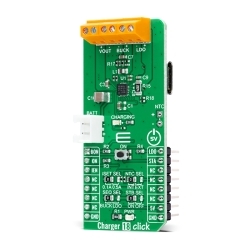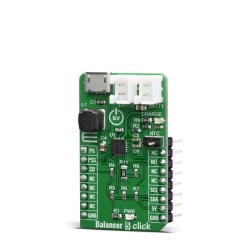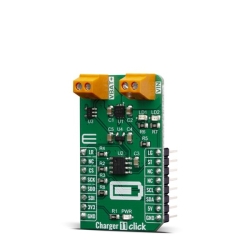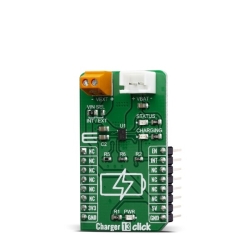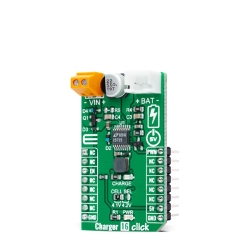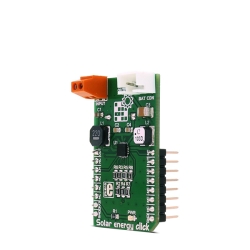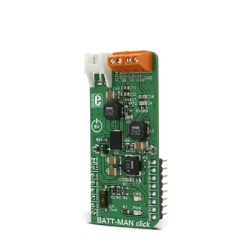MIKROE Charger 6 Click
Charger 6 Click is a compact add-on board that represents a single-cell battery charger.
Product Overview
Charger 6 Click is a compact add-on board that represents a single-cell battery charger. This board features the BQ25601, an I2C controlled battery charger for high input voltage and narrow voltage DC power path management from Texas Instruments. This buck charger supports USB, and it’s optimized for USB voltage input. The low impedance power path optimizes switch-mode operation efficiency, reduces battery charging time, and extends battery life during discharge. It also has a programmable current limiting, allowing it to use an external power supply rated up to 13.5V. This Click board™ is suitable as a Li-Ion and Li-polymer battery charger for portable devices and accessories, power tools, and more.
DC Motor 17 Click is supported by a mikroSDK compliant library, which includes functions that simplify software development.
Charger 6 Click as its foundation uses the BQ25601, a fast-charging solution for single-cell Li-Ion and Li-polymer battery with high input voltage suitable for a wide range of smartphones, tablets, and portable devices from Texas Instruments. The low impedance power path optimizes switch-mode operation efficiency, reduces battery charging time, and extends battery life during discharge. It is optimized for USB 5V voltage input, has a programmable current limiting based on the built-in USB interface, and allows the use of an external power supply from 3.9 to 13.5V. The BQ25601 also meets USB On-the-Go (OTG) operation power rating specification by supplying 5.15 V on the VBUS line with a constant current limit of up to 1.2A. The device provides automatic power path selection on the SYS line from the VBUS input source, battery, or both.
The power path management regulates the system slightly above battery voltage but does not drop below 3.5 V minimum system voltage. With this feature, the system maintains operation even when the battery is completely removed. When the input current limit or voltage limit is reached, the power path management automatically reduces the charge current to zero. As the system load increases, the power path discharges the battery until the system power requirement is met.
Charger 6 Click communicates with MCU using the standard I2C 2-Wire interface and supports both Standard and Fast Mode with a transfer rate of 100 and 400kbit/s. The I2C serial interface with charging and system settings makes this Click board™ a truly flexible solution. Also, it uses several GPIO pins, one of which is an interrupt pin, the INT pin of the mikroBUS™ socket, used as a ‘fault’ indicator. This pin sets immediately notifies the host when a fault occurs.
This Click board™ also uses two LED indicators, labeled as PG and STAT, used as power good and charging status indicator. PG indicates a good input source if the input voltage is above the SLEEP mode threshold and the current limit is above 30mA, while STAT reports the charging status and any fault conditions. CE pin routed to the CS pin on the mikroBUS™ socket enables battery charging process by setting this pin into a low logic state. PSEL pin routed to the PWM pin on the mikroBUS™ socket is used as a power source selection input and sets 500mA input current limit by pulling this pin high, otherwise set 2.4A input current limit by pulling this pin low. The BQ25601 also provides a QON pin, routed to the RST pin on the mikroBUS™ socket, for BATFET enable and reset control, to exit low-power mode or whole system reset function.
The charger provides a temperature monitoring feature selectable via jumper labeled as TEMP SEL, where the user can choose between external or internal mode of monitoring. For external mode, a single thermistor input for the battery temperature monitor is provided.
This Click board™ can be operated only with a 3.3V logic voltage level. The board must perform appropriate logic voltage level conversion before use with MCUs with different logic levels. However, the Click board™ comes equipped with a library containing functions and an example code that can be used, as a reference, for further development.
Features & Specs
- Interface: I2C
- Compatibility: mikroBUS™
- Dimensions: 42.9 x 25.4mm
- Input Voltage: 3.3V, External
- Supply Voltage VCC: 3.3V
- Supply Voltage VBAT: Min. 3.9V, Max. 13.5V
- Output Voltage VSYS: Min. 3.68V, Max. 4.45V
- Battery Charging Voltage: Min. 3.856V, Max. 4.624V
- Battery Charging Output Current: Min. 0A, Max. 3A
- Operating Temperature Range: Min. -40°C, Typ. +25°C, Max. +85°C
Documentation
Customer Reviews
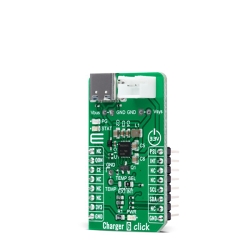
Stock and Customer Discounts
Available Discounts
- $11.35 | 25+ units
- $10.76 | 100+ units


